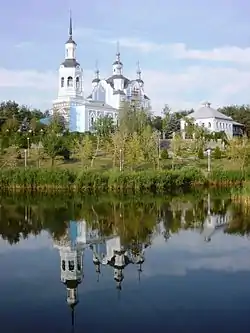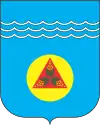Horishni Plavni
Horishni Plavni (Ukrainian: Горішні Плавні, before 2016 known as Komsomolsk-na-Dnipri, Ukrainian: Комсомо́льськ-на-Дніпрі or simply Komsomolsk, Ukrainian: Комсомо́льськ) is a purpose-built mining city in central Ukraine, located on the left bank of the Dnieper. Horishni Plavni is a city of regional significance of Poltava Oblast, practically conurbated with the larger neighboring city of Kremenchuk. Population: 50,816 (2020 est.)[1]
Horishni Plavni
Горішні Плавні | |
|---|---|
 Saint Nicholas Cathedral, Horishni Plavni | |
 Flag  Coat of arms | |
 Horishni Plavni Horishni Plavni on the map of Ukraine | |
| Coordinates: 49°01′N 33°40′E | |
| Country | Ukraine |
| Oblast | Poltava Oblast |
| Founded | 1960 |
| Town status | 1972 |
| Area | |
| • Total | 7.73 km2 (2.98 sq mi) |
| Population (2020) | |
| • Total | 50,816 |
| • Density | 6,600/km2 (17,000/sq mi) |
| Time zone | UTC+2, UTC+3 |
| Postal code | 39800-39890 |
| Area code(s) | +380 5348 |
| Website | www |
Outline
Founded in 1960 as Komsomolsk-na-Dnipri, the city was purposely planned and built as the residential and civic area for the Poltava Mining and Extraction Combinat (now controlled by the Ferrexpo) - the most important iron ore-mining company in Ukraine. 80% of the city residents are employed by the mining industry. There are two gigantic open pit mines and several spoil tips on the city territory, to the north-east and south of the residential area.
The industry is served by several railway stations. However, the passenger service was discontinued and the city relies on intercity and suburban bus links. The combinat operates its own freight river port.
Due to the profitability of mining, small city of Horishni Plavni usually ranks high in all-Ukraine city rankings of birth rate, living standards, (un)employment and housing.
On 15 May 2015 President of Ukraine Petro Poroshenko signed a bill into law that started a six months period for the removal of communist monuments and the mandatory renaming of settlements with a name related to Communism.[2] On 19 May 2016, Verkhovna Rada adopted decision to rename Komsomolsk as Horishni Plavni and conform to the law prohibiting names of Communist origin.[3]
See also
- Kostyantin Zhevago
- Ruslan Trokhnyuk
References
- "Чисельність наявного населення України (Actual population of Ukraine)" (PDF) (in Ukrainian). State Statistics Service of Ukraine. Retrieved 30 September 2020.
- Poroshenko signed the laws about decomunization. Ukrayinska Pravda. 15 May 2015
Poroshenko signs laws on denouncing Communist, Nazi regimes, Interfax-Ukraine. 15 May 20
Goodbye, Lenin: Ukraine moves to ban communist symbols, BBC News (14 April 2015) - Рада перейменувала Дніпродзержинськ на Кам'янське (in Ukrainian). Українські Національні Новини. 19 May 2016. Archived from the original on May 19, 2016. Retrieved 19 May 2016.CS1 maint: unfit URL (link)
External links
 Media related to Category:Horishni Plavni at Wikimedia Commons
Media related to Category:Horishni Plavni at Wikimedia Commons- Ferrexpo corporate web site
- Law of Ukraine "On the change of city boundaries for the city of Komsomolsk, Poltava Oblast" (in Ukrainian)